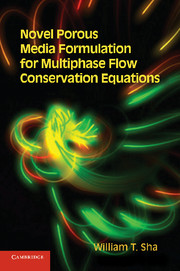Book contents
- Frontmatter
- Contents
- Figures and Table
- Foreword
- Foreword
- Foreword
- Nomenclature
- Preface
- Acknowledgments
- 1 Introduction
- 2 Averaging relations
- 3 Phasic conservation equations and interfacial balance equations
- 4 Local volume-averaged conservation equations and interfacial balance equations
- 5 Time averaging of local volume-averaged conservation equations or time-volume-averaged conservation equations and interfacial balance equations
- 6 Time averaging in relation to local volume averaging and time-volume averaging versus volume-time averaging
- 7 Novel porous media formulation for single phase and single phase with multicomponent applications
- 8 Discussion and concluding remarks
- Appendix A
- Appendix B
- Appendix C
- Appendix D
- References
- Index
7 - Novel porous media formulation for single phase and single phase with multicomponent applications
Published online by Cambridge University Press: 07 October 2011
- Frontmatter
- Contents
- Figures and Table
- Foreword
- Foreword
- Foreword
- Nomenclature
- Preface
- Acknowledgments
- 1 Introduction
- 2 Averaging relations
- 3 Phasic conservation equations and interfacial balance equations
- 4 Local volume-averaged conservation equations and interfacial balance equations
- 5 Time averaging of local volume-averaged conservation equations or time-volume-averaged conservation equations and interfacial balance equations
- 6 Time averaging in relation to local volume averaging and time-volume averaging versus volume-time averaging
- 7 Novel porous media formulation for single phase and single phase with multicomponent applications
- 8 Discussion and concluding remarks
- Appendix A
- Appendix B
- Appendix C
- Appendix D
- References
- Index
Summary
A generic three-dimensional, time-dependent family of COMMIX codes for single phase with multicomponent has been developed based on the novel porous media formulation. In the novel porous media formulation, each computational cell is characterized by volume porosity (γv), directional surface porosities ($\gamma _{\hbox{\scriptsize{\scitshape a}}x}$, $\gamma _{\hbox{\scriptsize{\scitshape a}}y}$, and $\gamma _{\hbox{\scriptsize{\scitshape a}}z}$ for Cartesian coordinates), distributed resistance (${}^{3i} \langle \underline R _{ k} \rangle$), and distributed heat source and sink (${}^{3i} \langle S_k \rangle$) through input data. The formulation can readily be brought back to the conventional porous media formulation and continuum formulation by setting $\gamma _{\hbox{\scriptsize{\scitshape a}}x} = \gamma _{\hbox{\scriptsize{\scitshape a}}y} = \gamma _{\hbox{\scriptsize{\scitshape a}}z} = 1$ and $\gamma _v = \gamma _{\hbox{\scriptsize{\scitshape a}}x} = \gamma _{\hbox{\scriptsize{\scitshape a}}y} = \gamma _{\hbox{\scriptsize{\scitshape a}}z} = 1$, respectively [,]. In fact, in many practical engineering analyses, the computational domain can be subdivided into many subdomains. Some of these subdomains are more suitable to use the conventional porous media formulation (e.g., reactor core) and others are appropriate to use the continuum formulation (e.g., for a reactor upper plenum, where there are no solid structures). With appropriate input of the volume porosity, directional surface porosities, distributed resistance, and distributed heat source and sink for each computation cell, the novel porous media formulation enables engineers and scientists to solve challenging real world engineering problems with complex stationary solid structures.
Most of our experience with the novel porous media formulation had been in single phase and single phase with multicomponent applications, and limited in two-phase flow with conservation equations approximated as a set of partial differential equations. Recently, we developed the novel porous media formulation from single phase to multiphase as described in this book (see ). These conservation equations are in differential-integral form and are not a set of partial differential equations, as currently appear in most literature on two-phase and multiphase flow. To the best of our knowledge, no one has ever solved the conservation equations in the differential-integral forms that are presented in this book. Engineers and scientists have been working on two-phase flow throughout the world since the Industrial Revolution in late 18th century. It is startling to realize that the correct conservation equations of mass, momentum, and energy for two-phase flow analysis have not been used since the invention of steam engines and boilers more than 100 years ago.
- Type
- Chapter
- Information
- Publisher: Cambridge University PressPrint publication year: 2011



